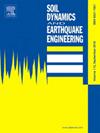应用极点分配优化以麦克斯韦模型为代表的被动粘性阻尼器
IF 4.2
2区 工程技术
Q1 ENGINEERING, GEOLOGICAL
引用次数: 0
摘要
麦克斯韦模型用于了解建筑结构减振的实际效果。该模型由一个串联的仪表盘和弹簧组成。冲杆和弹簧分别代表粘性阻尼器和阻尼器与结构框架之间的连接。然而,很少有研究对实际参数范围内的最佳阻尼器容量和相应的弹簧刚度进行调查。此外,利用定点理论推导出的最佳阻尼器与通过极点分配推导出的最佳阻尼器没有关系。因此,在本研究中,为了研究联合弹簧的影响,我们使用极点分配法设计了一个结构系统,其中将麦克斯韦模型纳入了单自由度阻尼模型。我们引入了一个闭式表达式,明确描述了目标结构阻尼比、阻尼器容量和关节弹簧之间的关系。麦克斯韦模型利用阻尼器参数对控制效果进行了约束,并同时为阻尼器提出了一个最佳和现实的关节弹簧。极点分配还应用于采用多个麦克斯韦模型的多自由度(M-DOF)阻尼结构系统。新提出的优化关节弹簧可以轻松控制 M-DOF 系统的额外阻尼效应。麦克斯韦模型几乎可以手动优化。与之前的数值优化相比,该方案在初步设计阶段更加有用。本研究将控制建筑振动的数学方程扩展到了麦克斯韦模型。扩展方程是考虑结构被动控制的统一描述。本文章由计算机程序翻译,如有差异,请以英文原文为准。
Application of pole allocation to optimize passive viscous dampers represented by the Maxwell model
The Maxwell model is used to understand the realistic effectiveness of vibration reduction in the building structures. The model consists of a dashpot and spring in series. The dashpot and spring represent a viscous damper and joint between the damper and the structural frame, respectively. However, few studies have investigated the optimal damper capacity and the corresponding spring stiffness in the practical parameter ranges. Additionally, the optimal damper derived using the fixed-point theory has no relationships with that derived via pole allocation. Therefore, in this study, to examine the effects of the joint spring, the pole allocation method was used to design a structural system wherein the Maxwell model was incorporated into a single-degree-of-freedom damped model. We introduced a closed-form expression, which explicitly described the relationships between the target structural damping ratio, damper capacity, and joint spring. The Maxwell model constrained the control effectiveness using damper parameters and simultaneously suggested an optimal and realistic joint spring for the damper. Pole allocation was also applied to a multi-degree-of-freedom (M-DOF) damped structural system employing multiple Maxwell models. The newly proposed optimized joint spring could easily control the additional damping effect on the M-DOF system. The Maxwell model can be optimized almost manually. The scheme is more useful in the preliminary design stage than the previous numerical optimizations. This study extended the mathematical equation governing the building vibrations to the Maxwell model. The extended equation served as a unified description for considering structural passive control.
求助全文
通过发布文献求助,成功后即可免费获取论文全文。
去求助
来源期刊

Soil Dynamics and Earthquake Engineering
工程技术-地球科学综合
CiteScore
7.50
自引率
15.00%
发文量
446
审稿时长
8 months
期刊介绍:
The journal aims to encourage and enhance the role of mechanics and other disciplines as they relate to earthquake engineering by providing opportunities for the publication of the work of applied mathematicians, engineers and other applied scientists involved in solving problems closely related to the field of earthquake engineering and geotechnical earthquake engineering.
Emphasis is placed on new concepts and techniques, but case histories will also be published if they enhance the presentation and understanding of new technical concepts.
 求助内容:
求助内容: 应助结果提醒方式:
应助结果提醒方式:


